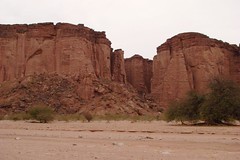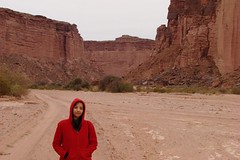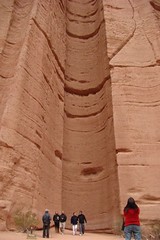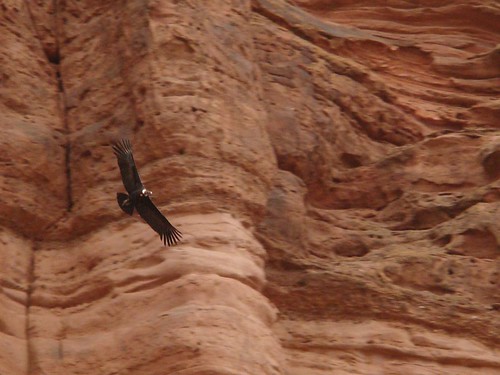Two days after our first, failed attempt, we finally got to see the Talampaya National Park. This was what we'd come to La Rioja for, so we were exhilarating.
The weather had changed. It was cloudy and rather cool, and the tour guide warned us about being so happy, since there was a possibility, if remote, that it could rain. I made the mistake of not taking along more warm clothes than I had already on...
The trip felt shorter than before. The Cuesta de Miranda wasn't full of splendour under the sun like the previous Tuesday, but dark, with deep colours toned down by the cloud cover. We got to the park's entrance, registered, and then the van kept on going for 12 km. The Talampaya National Park is huge (2,150 km²), but the touristic part, the one you can actually visit, is just the canyon formed by the Talampaya river (which is a dry bed of dust most of the time), with rocky walls chiseled by wind erosion.
We got to the canyon and got off the van to do our trekking. It was bitterly cold and the wind didn't help it, but luckily it hit us from the back. I immediately realized I should've brought at least two more layers of protective warm clothing, plus a scarf, gloves and a wool cap. Marisa was a bit better protected than me and she had a hood over her head; the tips of my ears painfully froze in a matter of minutes.
All this notwithstanding, when you walk for a while at a good pace you forget the cold, even more so when you have such a great spectacle before your eyes. At this point I must let the pictures speak for themselves, because I don't have proper words to describe the immensity of the view. All I was left with was impressions — the clearest one being one the guide made us notice, our inability to grasp the sheer height of the canyon's walls. I don't know how much they were apart; for us, walking along the midline of the utterly dry riverbed, they seemed close enough, but when we tried to get closer we noticed we were never there, it took us a minute or so to get to where your hand could actually touch the reddish rock wall, and then you looked up and it was impossible to see the end of it. The Talampaya Canyon's walls are up to 180 metres high, equivalent to a 60-storey building (there are none so high in Argentina, by the way).
Our other impression was that of geological age. The wind we felt was dragging and blowing sand and dust; that we could see. But it was hard to relate that to the worn-down, polished, modelled walls. How many millions of years of wind and sand there were on those rocks, I don't know.
The guide showed us petroglyphs, symbols and human and animal characters carved on the surface of the rocks by the ancient natives of the place, who didn't live there but sent their shamans to perform occult ceremonies there (some pictures of petroglyphs can be viewed on my other blog). It's easy to understand how they came to believe the canyon was appropriate for the supernatural; I myself, who don't believe in it, had a perception of concreteness, of such overwhelming solidity that it felt more than sheer material stuff. (Even now my regret is not having touched those rocks with my bare hands a little more. It sounds incredible, but I hardly touched them.)
In a couple of spots, the shape of the rocks and the canyon multiplies the echoes. A cry uttered there rebounds so that you can hear entire sentences repeat themselves four or five times, clearly, all along the walls, at a great distance.
In another spot, a fortuitous combination of factors make the scarce humidity of the place gather and create a natural "garden", with several typical desert tree species. Besides trees and bushes there are maras (wrongly called Patagonian hares — they're cousins of Guinea pigs).
The climax of our experience was looking up and seeing two black shapes gliding among the red peaks, perching on a rock for a while, then flying again. They were condors. There was no way to estimate their size, but we knew a condor can have a wingspan of three metres and these were at high altitude.
A van full of tourists went by and came back after a while. The passengers glared at us, confused. What were we doing outside in this freezing weather, walking miles along the canyon? And just what were looking at so eagerly, up in the sky? Our guide explained that many tourists, instead of hiring the full tour, come by themselves to the park. As they arrive, the management offers them to ride on their vans (it's how they do business). The tour on the van is much cheaper than doing the trip from Chilecito, getting off and hike for two and a half hours with a guide on your side, but it's much more partial. The whole show is reduced to what you can see from the van's windows. Of course you can't see the condors. I don't know what those poor tourists are told, but based on what the guide said, many tourists who came to see the canyon realize only later than they've been sold a very small part of it.
As we walked into the "garden", a shower of tiny, cold things floated down from the sky. It was (barely) snowing. I was happy as a child. Where I live it hasn't snowed since before I was born. Once in my life had I touched snow, when I was 17, in Bariloche.
We took the way back. The wind now blew into our faces. I felt my nose freezing over. Marisa had lost all the healthy colour she'd acquired during the previous days outdoors. Our hands were livid, devoid of blood. It couldn't be much above zero degrees, and there was no shelter. After what seemed like eternity, we came back to the parked van. It took us a while to stop shivering.
In the Cuesta de Miranda, 2,000 metres above sea level, it was snowing with minuscule snowflakes of a white so white it looked fake, like a rain of fine-grained expanded polystyrene; the clouds veiled the peaks. Coming down from those heights, we saw again the already familiar hills of the Famatina, the highest of them subtly covered with snow. It wasn't much, but I hope it helped. In Chilecito, when there's no snow in the winter, there's no water in the summer.


















No comments:
Post a Comment
Note: Only a member of this blog may post a comment.